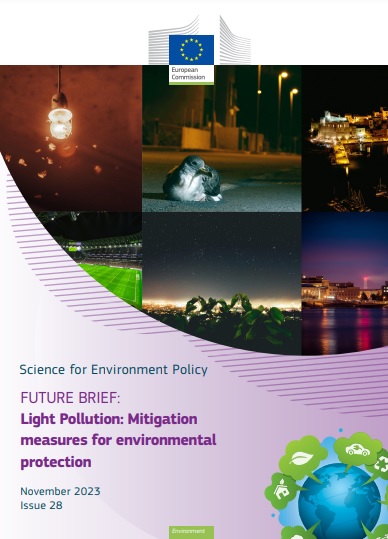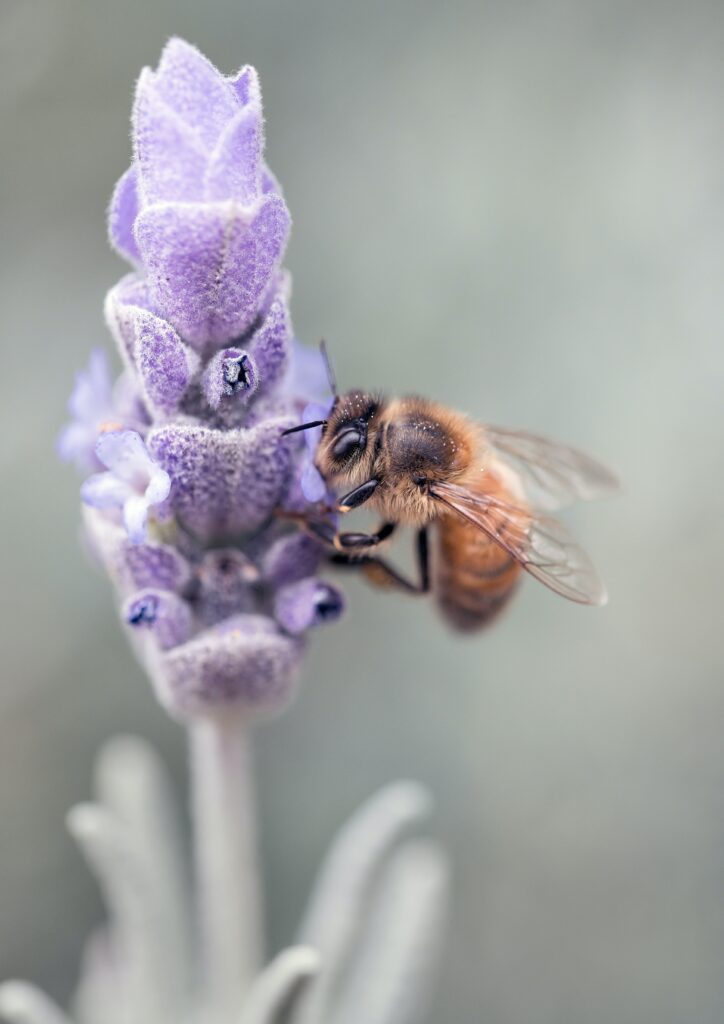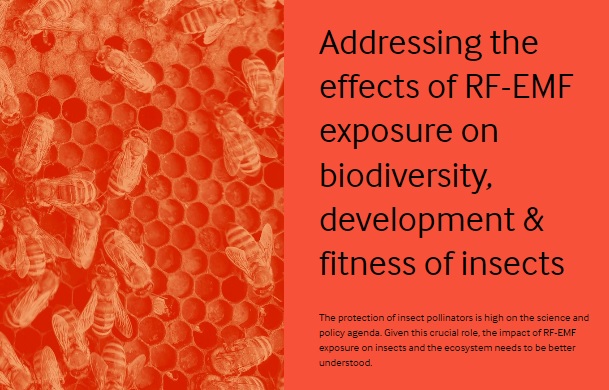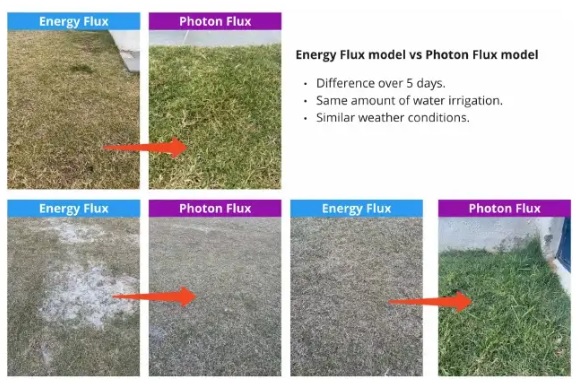
16th of December 2023
Widely known causes of insect decline are deforestation, pesticide use, artificial light pollution and climate change.
Although there is growing concern about the effect of anthropogenic (man made) electromagnetic radiation exposure to insects we cannot ignore the effect of another type of anthropogenic EMR, artificial light at night (ALAN).
Vanbergen et al.,2019: “The extent that anthropogenic EMR (ALAN or AREMR) represents a significant threat to insect pollinators and the benefits they provide to nature and humankind therefore remains to be clearly established” (AREMR = anthropogenic radiofrequency electromagnetic radiation).

This Brief focuses on the lighting design adaptations and mitigation measures tailored for sensitive habitats and taxa. It also highlights ongoing efforts by local governments and communities to address Artificial Light at Night pollution (ALAN).
As per the Brief, regarding insects
Insects
There is concern that the increased usage of white LEDs will impact insects as they are more sensitive to short wavelengths. One group that is particularly prone to negative effects of ALAN are moths, and research has shown that light pollution affects their reproduction and development. In turn, it also affects the composition of moth assemblages and the ecosystem functions they perform.
The EU Pollinators Initiative is the first ever EU action framework to tackle the decline of wild pollinators. A workshop took place online in 2022, which aimed to strengthen actions to enhance pollinator friendly artificial night lighting in Europe, through the existing Pollinators Initiative (Stockhammer, Zulka and Schindler, 2022). Organised by DG Environment and the German Environment Agency (Umweltbundesamt), the workshop was aimed at experts across stakeholder groups, including public authorities, practitioners engaged in spatial planning, innovation and social change experts, academia, land managers and non- governmental organisations The resulting revised EU Pollinators Initiative was released in January 2023 9, recommending member states to mitigate the impact of light pollution through national and regional policies. The updated initiative also highlighted the Commission’s new guidelines on light pollution mitigation for cities10 and citizens for pollinator conservation11.
The revised EU Pollinators Initiative states that the Commission has integrated recommendations on how to mitigate light pollution into its guidelines for citizens and cities, and will continue to promote them (European Commission, 2023).
The interaction of light pollution with other pollutants is still poorly understood, and therefore a growing concern of the science community.
Two large scale interdisciplinary research projects investigating the impact of light pollution and effectiveness of mitigation measures, are planned to be funded within the Horizon Europe Research and Innovation Programme (HORIZON-CL6-2023-BIODIV01-2)17. Both projects will investigate light and noise pollution with respect to impacts on biodiversity and ecosystem services and innovative mitigation measures, with ‘AquaPlan’ (101135471), focussed on European seas lakes and rivers, whereas ‘Plan B’ (101135308) is focussed on terrestrial ecosystems.
What we can all do to reduce light pollution outside your house:
To lower skyglow in your city, town or village you can minimise light pollution outside your house, in your garden, terrace or front door. Do you need lights in these spaces all the time? If not, can they be used only at certain times of night? Motion activation or temporal lighting with automatic timers can help. Extinguish lights when not needed, or dim to the lowest acceptable light intensity. Use lights which are shielded – so light doesn’t travel upwards or downwards unnecessarily, and use warm lights with a red wavelength rather than a blue one. Lastly, simply close your curtains or shutters in the evening when you turn on lights inside your home (IEEP, 2020). https://environment.ec.europa.eu/publications/future-brief-light-pollution-mitigation-measures-environmental-protection-issue-28_en
Biomonitors

Mair KS, Irrgeher J, Haluza D. Elucidating the Role of Honey Bees as Biomonitors in Environmental Health Research. Insects. 2023 Nov;14(11):874. DOI: 10.3390/insects14110874. PMID: 37999073; PMCID: PMC10671894
The study does not consider anthropogenic light or EMF exposure but provides an insight into the biomonitoring of the honey bee and how it delivers valuable information on the state of the shared environment and how well honey bees can help us monitor pollutants from an environmental health perspective.
The earliest publication on the use of honey bees as bioindicators dates back to 1935, when Svoboda reviewed the negative effects of industrial pollutants on honey bees in former Czechoslovakia, as stated by Porrini et al. [5]. Since then, honey bees have been used in numerous biomonitoring studies, ranging from assessing radionuclides after the nuclear plant incident at Chernobyl to determining pesticide contamination at agricultural sites [5,6,7,8,9].
The systematic literature review provided a comprehensive overview of the utilization of the honey bee as a tool for pollutant monitoring, encompassing articles published within the decade spanning from 2010 to 2020. Nineteen studies were included in the systematic literature review. Of these studies, the majority (n = 15) focused on the detection of heavy metals in honey bees and beehive products, while 4 studies focused on air pollution by polycyclic aromatic hydrocarbons or particulate matter.
The authors state that by using the One Health approach, a safer world for all living creatures, fostering a balance between human development and the preservation of ecosystems, can be achieved. This concept not only protects human health but also recognizes the intrinsic value of biodiversity and the critical role animals and the environment play in our shared well-being. From an environmental health viewpoint, the honey bee can be considered as a model organism for the One Health concept [19].
Read the full article https://europepmc.org/article/MED/37999073
Biological effects of electromagnetic fields on insects: a systematic review and meta-analysis
This systematic review summarizes the results of studies investigating the toxicity of electromagnetic fields in insects. According to the authors, biological effects of non-thermal EMF on insects are clearly proven in the laboratory, but only partly in the field, thus the wider ecological implications are still unknown. Reference: Thill, Alain, Cammaerts, Marie-Claire and Balmori, Alfonso. “Biological effects of electromagnetic fields on insects: a systematic review and meta-analysis” Reviews on Environmental Health, 2023. https://doi.org/10.1515/reveh-2023-0072


ETAIN is part of the CLUE-H cluster focused on Electromagnetic Fields, Health Risks, and 5G
By developing anatomically and electromagnetically accurate 3D ElectroMagnetic (3D-EM) models of insects, the project quantifies potential changes in their RF-EMF exposure and answers the question whether (non-) thermal effects in insects could occur.
Honey Bees, solitary bees and blue bottle flies will also be studied to test if RF-EMF exposure impacts the immature development and fitness of insect pollinators.
The absorption and penetration of RF-EMF in insects is expected to increase due to the shift towards 5G and 6G, caused by resonance effects in small bodies.
ETAIN updates systematic reviews on RF-EMF health effects with upcoming evidence from the scientific literature, results from this project such as effects on skin, eye, insects and other anticipated results while creating a white paper with policy recommendations. https://www.etainproject.eu/the-project
Climate Change

“We warn that, if no action is taken to better understand and reduce the action of climate change on insects, we will drastically reduce our ability to build a sustainable future based on healthy, functional ecosystems.” Harvey et al., 2022
Outdoor lighting is not currently included in the 2030 Agenda for Sustainable Development, adopted by all members to the United Nations, although most of the 17 sustainable development goals are impacted by light pollution.
To ensure a more ecological sustainable future in Europe, and globally, individuals, cities, governments and international conservation organisations need to include the effects of anthropogenic lighting in planning and decision-making. https://environment.ec.europa.eu/publications/future-brief-light-pollution-mitigation-measures-environmental-protection-issue-28_en
Climate impact disclosure
Despite mobile operators being at the forefront of net zero ambitions and most disclosing their climate impacts, a significant part of the ecosystem currently does not report its impact. Of total global connections, 2.8 billion (34%) are currently provided by mobile operators that do not disclose their climate impact. While operators from more developed countries are likely to have higher levels of disclosure, less developed countries in Asia and Africa have the strongest representation in the list of those that do not disclose. To fully understand the emissions of the mobile industry, harmonised and ubiquitous climate impact disclosure is essential.
5G
Although 5G offers a significant energy-efficiency improvement per gigabyte when compared to previous technologies, new 5G use cases and the adoption of mmWave will require more sites and antennas. This leads to the prospect of a more efficient network that could paradoxically result in higher emissions in the absence of active intervention. 5G is the first wireless technology where energy efficiency has been considered during standardisation.
Each cellular technology has become more energy efficient since 2G as the transmission technology has improved. On top of this, a number of energy saving measures are built into the 5G standard, such as sleep or shutdown functions in the transceiver and a low-energy scheduler solution. 5G has been designed with network energy efficiency in mind, with 5G’s specification offering the potential for a 90% reduction in energy use to transfer each bit of data compared to previous wireless technologies. https://www.gsma.com/betterfuture/wp-content/uploads/2022/05/Moble-Net-Zero-State-of-the-Industry-on-Climate-Action-2022.pdf
Solutions that are effective, economical and pragmatic – South African National Report 2022
The number of LIGHT, EMF and Climate Change related complaints received by various government departments has been increasing over time. In the past, these have not been handled optimally, but there is now a general consensus to strive toward cooperative solutions and synergy. One of the proposed means employed is to increase both technical and non-technical communication strategies. This will encourage the nation’s inhabitants to become citizen scientists in a pedagogy that is aligned with this committee’s voice. Dialogue and growth in working together is needed and why the designed and carried out solutions in this report are effective- economical and pragmatic, enabling all residents of SA and globally to employ, test, and enhance within their own personal spaces, work and government facilities.
Example:


Reference:
Lech, James; Krüger, Tjaart; Boros, László; Venter, Derik; Obajuluwa, Adejoke; Abrahamse, Heidi; et al. (2022). World Health Organization – International EMF Project – International Advisory Committee (IAC) – 11th anniversary of the International Optical Radiation and 26th anniversary of EMF Project meeting, World Health Organization – International EMF Project – International Advisory Committee (IAC) . figshare. Conference contribution. https://doi.org/10.6084/m9.figshare.20012759.v1; also available at
In conclusion
It is vital to lead by example and adapt our residences and businesses accordingly for the sake of environmental health.
